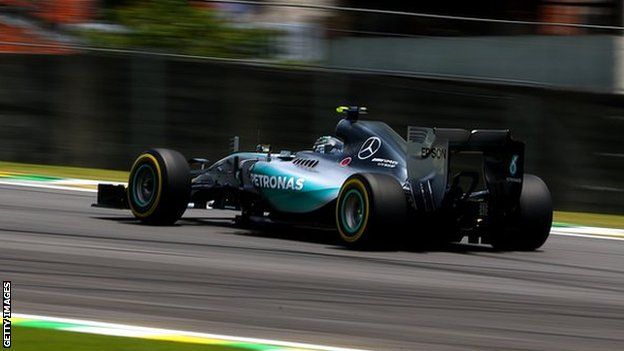F1 to end engine restrictions in bid to improve competition
- Published
- comments

Mercedes have dominated F1 for the past two years
Formula 1 plans to remove restrictions on engine development for 2017.
The move, which has been agreed by the teams but still needs to be officially ratified, will mean the end of the complicated 'token' system.
Mercedes has dominated F1 since the introduction of turbo hybrid engines in 2014, winning the drivers' and constructors' championships for the past two seasons.
The hope is that freeing up development will allow rivals to catch up.
The 'token' system, which limited what can be done to engines and when, aimed to keep costs under control.
But senior figures feel it has introduced unnecessary complexity and restricted the ability of manufacturers to improve their engines.
How did the token system work?
When turbo hybrid engines were introduced, in-season development was banned altogether, and the changes that manufacturers were allowed to make over each winter were increasingly limited as the years went by.
Engines were divided up into 66 parts, with each part ascribed up to three tokens, depending on their influence on the performance of the engine.
Companies were given up to 32 tokens to develop their engines in 2015.
The original plan was for that number to drop to 25 for 2016 and to continue decreasing, down to three in 2019 and 2020.
But now the whole system has been scrapped for 2017.
Why has it been axed?
The idea, from the same manufacturers who have now agreed to ditch it, attempted to prevent costs spiralling out of control.
But it had a number of flaws:
it meant any disadvantage an engine had at the start of a season was locked in for a year with no way of reducing it;
the ever-tightening series of restrictions year-to-year risked locking in a permanent advantage for some and a permanent disadvantage for others;
it made entering F1 less attractive to companies considering an entry, as they were controlled by the same restrictions at the same time as those who were already taking part, but without the benefit of the race experience accrued.
Various attempts to undermine the system began as soon as it became clear Mercedes had a significant advantage in 2014.
For 2015, restricted in-season development was permitted after Ferrari discovered a loophole in the regulations.
A compromise was also agreed to ensure new entrant Honda was given time to develop its engine.
So what now?
For 2016, in-season development has again been allowed, while the number of tokens each manufacturer can use has been increased to 32.
But then it will change for 2017.
Drivers will still be limited to four engines per season.
The one restriction on development will be that new parts can only be fitted when a team changes one of six elements that make up a car's power-unit.
Those six elements are:
the internal combustion engine;
the turbo charger;
the energy store;
the control electronics;
and the two motor generator units.
The 2016 season gets under way in Australia on 20 March.
- Published4 February 2016
- Published3 February 2016
- Published3 February 2016
- Published18 December 2015
- Published2 November 2018
- Published26 February 2019